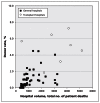Organ donation after death in Ontario: a population-based cohort study
- PMID: 23549970
- PMCID: PMC3652962
- DOI: 10.1503/cmaj.122047
Organ donation after death in Ontario: a population-based cohort study
Abstract
Background: Shortfalls in deceased organ donation lead to shortages of solid organs available for transplantation. We assessed rates of deceased organ donation and compared hospitals that had clinical services for transplant recipients (transplant hospitals) to those that did not (general hospitals).
Methods: We conducted a population-based cohort analysis involving patients who died from traumatic brain injury, subarachnoid hemorrhage, intracerebral hemorrhage or other catastrophic neurologic conditions in Ontario, Canada, between Apr. 1, 1994, and Mar. 31, 2011. We distinguished between acute care hospitals with and without transplant services. The primary outcome was actual organ donation determined through the physician database for organ procurement procedures.
Results: Overall, 87,129 patients died from catastrophic neurologic conditions during the study period, of whom 1930 became actual donors. Our primary analysis excluded patients from small hospitals, reducing the total to 79,746 patients, of whom 1898 became actual donors. Patients who died in transplant hospitals had a distribution of demographic characteristics similar to that of patients who died in other large general hospitals. Transplant hospitals had an actual donor rate per 100 deaths that was about 4 times the donor rate at large general hospitals (5.0 v. 1.4, p < 0.001). The relative reduction in donations at general hospitals was accentuated among older patients, persisted among patients who were the most eligible candidates and amounted to about 121 fewer actual donors per year (adjusted odds ratio 0.58, 95% confidence interval 0.36-0.92). Hospital volumes were only weakly correlated with actual organ donation rates.
Interpretation: Optimizing organ donation requires greater attention to large general hospitals. These hospitals account for most of the potential donors and missed opportunities for deceased organ donation.
Figures



Comment in
-
Exemplary medicine: why doctors should practise what they preach.CMAJ. 2013 May 14;185(8):635. doi: 10.1503/cmaj.130514. CMAJ. 2013. PMID: 23670866 Free PMC article. No abstract available.
-
Organ donation programs needed in rural areas.CMAJ. 2013 Oct 1;185(14):1252. doi: 10.1503/cmaj.113-2137. CMAJ. 2013. PMID: 24082046 Free PMC article. No abstract available.
References
-
- Gortmaker SL, Beasley CL, Brigham LE, et al. Organ donor potential and performance: size and nature of the organ donor shortfall. Crit Care Med 1996;24:432–9 - PubMed
-
- Sheehy E, Conrad SL, Brigham LE, et al. Estimating the number of potential organ donors in the United States. N Engl J Med 2003;349:667–74 - PubMed
-
- Scales DC, Granton JT. Care of the critically ill transplant patient. In: Principles of citical care. Hall JB, Schmidt GA, Wood LDH, editors. 3rd ed New York (NY): McGraw-Hill; 2005
-
- Hauptman PJ, O’Connor KJ. Procurement and allocation of solid organs for transplantation. N Engl J Med 1997;336:422–31 - PubMed
Publication types
MeSH terms
Grants and funding
LinkOut - more resources
Full Text Sources
Other Literature Sources
Medical
Miscellaneous
